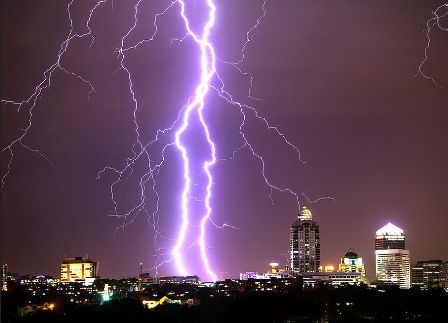What is lightning and how does it occur?
The origin of thunderclouds
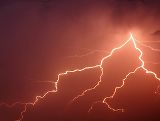 Fog rising high above the ground consists of water particles and forms clouds. Larger and heavier clouds are called cumulus clouds. Some clouds are simple—they do not cause lightning or thunder. Others are called thunderstorms because they create a thunderstorm, form lightning and thunder. Thunderclouds differ from ordinary rain clouds in that they are charged with electricity: some are positive, some are negative.
Fog rising high above the ground consists of water particles and forms clouds. Larger and heavier clouds are called cumulus clouds. Some clouds are simple—they do not cause lightning or thunder. Others are called thunderstorms because they create a thunderstorm, form lightning and thunder. Thunderclouds differ from ordinary rain clouds in that they are charged with electricity: some are positive, some are negative.
How are thunderclouds formed? Everyone knows how strong the wind is during a thunderstorm. But even stronger air vortices form higher above the ground, where forests and mountains do not impede the movement of air. This wind generates mostly positive and negative electricity in the clouds.
There is positive electricity at the center of each drop, and an equal amount of negative electricity is found along the surface of the drop. Falling raindrops are caught by the wind and fall into air currents. The wind, hitting the drop with force, breaks it into pieces.In this case, the detached outer particles of the droplet become charged with negative electricity.
The remaining larger and heavier part of the droplet is charged with positive electricity. The part of the cloud where heavy droplets accumulate is charged with positive electricity. The rain that falls from the cloud transfers some of the cloud's electricity to the ground, and thus an electrical attraction is created between the cloud and the ground.
In fig. 1 shows the distribution of electricity in a cloud and on the surface of the earth. If a cloud is charged with negative electricity, then, striving to be attracted to it, the positive electricity of the earth will be distributed over the surface of all elevated objects that conduct electric current. The higher the object standing on the ground, the smaller the distance between the top and the bottom of the cloud and the smaller the layer of air that remains here, giving off the opposite electricity. It is obvious that lightning penetrates the ground more easily in such places. We will tell you about this in more detail later.
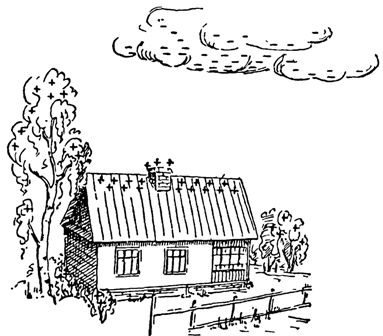
Rice. 1. Distribution of electricity in a thundercloud and ground objects
What causes lightning?
Approaching a tall tree or house, a thundercloud charged with electricity acts on it. In fig. 1 cloud charged with negative electricity attracts positive electricity to the roof, and the negative electricity of the house will go into the ground.
Both electricity—in the cloud and on the roof of the house—tend to attract each other. If there is a lot of electricity in the cloud, then a lot of electricity is formed on the house through the influence.
Just as incoming water can erode a dam and rush into a torrent, flooding a valley in its unrestricted movement, so electricity, increasingly accumulating in a cloud, can eventually break through the layer of air that separates it from the surface of the earth and rush down to the earth, to the opposite electricity. A strong discharge will occur—an electric spark will slide between the cloud and the house.
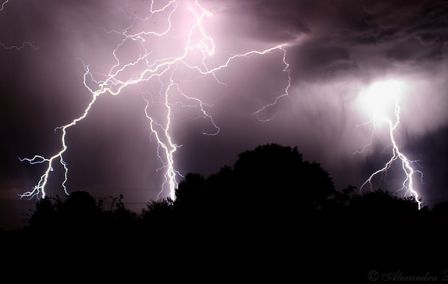
This is the lightning that strikes the house. Lightning discharges can occur not only between a cloud and the ground, but also between two clouds charged with different types of electricity.
The stronger the wind, the faster the cloud is charged with electricity. The wind expends a certain amount of work, which goes into separating the positive and negative electricity.
How does lightning develop?
Most often, lightning striking the ground comes from clouds charged with negative electricity. Lightning striking from such a cloud develops in this way.
First, small amounts of electrons begin to flow from the cloud to the ground, in a narrow channel, forming a sort of current in the air.
In fig. 2 shows this initiation of lightning formation. In the part of the cloud where the channel begins to form, electrons possessing a high speed of movement have accumulated, due to which they, colliding with air atoms, break them into nuclei and electrons.
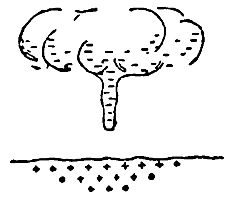
Rice. 2. Lightning starts to form in a cloud
The electrons released in this case also rush to the ground and, again colliding with the atoms of the air, separate them.It is like the falling of snow in the mountains, when at first a small lump, rolling down, grows covered with snowflakes stuck to it, and, speeding up its flight, becomes a great avalanche.
And here the electron avalanche captures new volumes of air, splitting its atoms into pieces. In this case, the air is heated, and as the temperature increases, its conductivity increases. It turns from an insulator into a conductor. Through the resulting conductive channel of air from the cloud, electricity begins to drain more and more. Electricity approaches the earth at a tremendous speed, reaching 100 kilometers per second.
In hundredths of a second, the avalanche of electrons reaches the ground. This ends only the first, so to speak, "preparatory" part of the lightning: the lightning has made its way to the ground. The second, major part of Lightning's development is yet to come. The considered part of the lightning formation is called the conductor. This foreign word means "leader" in Russian. The guide made way for the second, more powerful part of the lightning; this part is called the main part. As soon as the channel reaches the ground, electricity begins to flow through it much more violently and quickly.
Now there is a connection between the negative electricity accumulated in the channel and the positive electricity that has fallen to the ground with raindrops, and by electrical action there is a discharge of electricity between the cloud and the ground. Such a discharge is an electric current of enormous strength — this strength is much greater than the strength of the current in a conventional electrical network.
The current flowing in the channel increases very quickly, and after reaching the maximum strength, it begins to gradually decrease.The lightning channel through which such a strong current flows heats up a lot and therefore glows brightly. But the time of current flow in a lightning discharge is very short. The discharge lasts for very small fractions of a second and therefore the electrical energy produced during the discharge is relatively small.
In fig. 3 shows the gradual movement of the lightning conductor towards the ground (first three figures on the left).

Rice. 3. Gradual development of the lightning conductor (first three figures) and its main part (last three figures).
The last three figures show separate moments of the formation of the second (main) part of the lightning. A person looking at the flash would, of course, not be able to distinguish its guide from the main part, since they follow each other extremely quickly, on the same path.
After connecting two different types of electricity, the current is interrupted. Usually the lightning doesn't stop there. Often a new leader immediately rushes along the path blazed by the first throw, and behind him, on the same path, is again the eye part of the throw. This completes the second discharge.
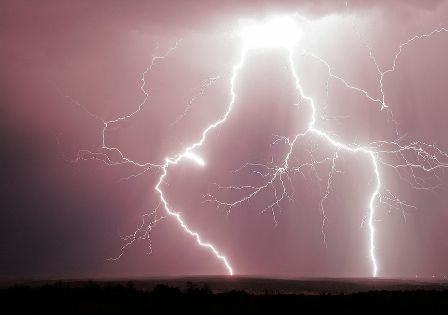
There can be up to 50 such separate categories, each consisting of its own leader and main body. Most often there are 2-3 of them. The appearance of separate discharges makes the lightning intermittent, and often a person looking at the lightning sees it flicker. This is what causes the flash to flicker.
The time between the formation of separate discharges is very short. It does not exceed hundredths of a second. If the number of discharges is very large, then the duration of lightning can reach a whole second or even several seconds.
We have considered only one type of lightning, which is the most common.This lightning is called linear lightning because it appears to the naked eye as a line—a narrow, bright band of white, light blue, or bright pink.
Line lightning has a length of hundreds of meters to many kilometers. The path of lightning is usually zigzag. Lightning often has many branches. As already mentioned, linear lightning discharges can occur not only between the cloud and the ground, but also between the clouds.
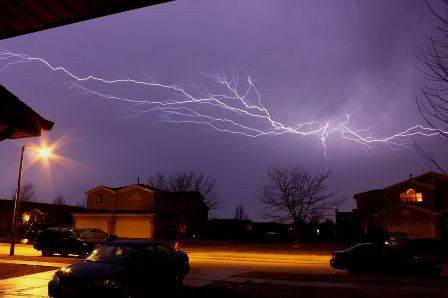
Ball lightning
In addition to linear, there are, however, much less often other types of lightning. We will consider one of them, the most interesting — ball lightning.
Sometimes there are lightning discharges that are fireballs. How ball lightning is formed has not yet been studied, but the available observations of this interesting type of lightning discharge allow us to draw some conclusions.
Most often, ball lightning is shaped like a watermelon or a pear. It lasts relatively long — from a fraction of a second to several minutes.
The most common duration of ball lightning is 3 to 5 seconds. Most often, ball lightning appears at the end of a thunderstorm in the form of red glowing balls with a diameter of 10 to 20 centimeters. In rarer cases, it is also large. For example, a lightning bolt with a diameter of about 10 meters was photographed.
The ball can sometimes be blindingly white and have very sharp outlines. Ball lightning usually makes a hissing, buzzing, or hissing sound.
Ball lightning can fade silently, but it can emit a faint crackle or even a deafening explosion. When it disappears, it often leaves a pungent smelling mist. Near the ground or indoors, ball lightning moves at the speed of a running man — approximately two meters per second.It can stay at rest for a while and such a "laid" ball hiss and sparks until it disappears. Sometimes ball lightning appears to be driven by the wind, but usually its movement is independent of the wind.
Ball lightning is attracted to enclosed spaces, where they penetrate through open windows or doors, and sometimes even through small cracks. Pipes are a good way for them; that's why fireballs often come out of ovens in kitchens. After traveling around the room, the ball of lightning leaves the room, often exiting along the same path it entered.
Sometimes the lightning rises and falls two or three times at distances of a few centimeters to a few meters. Simultaneously with these ups and downs, the fireball sometimes moves in a horizontal direction, and then the ball lightning appears to make jumps.
Often, ball lightning "settles" on wires, preferring the highest points, or rolls along wires, for example, along drainage pipes. Moving along people's bodies, sometimes under clothing, fireballs cause severe burns and even death. There are many descriptions of cases of fatal damage to people and animals by lightning. Heat lightning can cause very severe damage to buildings.
Where does lightning strike?
Since lightning is an electrical discharge through the thickness of the insulator - air, it most often occurs where the layer of air between the cloud and any object on the surface of the earth will be smaller. Direct observations show this: lightning tends to strike tall bell towers, masts, trees and other tall objects.
However, lightning rushes not only to high objects.From two adjacent masts of equal height, one made of wood and the other of metal, and standing not far from each other, lightning will rush to the metal one. This will happen for two reasons. First, metal conducts electricity much better than wood, even when wet. Second, the metal mast is well connected to the ground and electricity from the ground can flow more freely to the mast during leader development.
The latter circumstance is widely used to protect various buildings from lightning. The greater the surface area of the metal mast in contact with the ground, the easier it is for electricity from the cloud to pass into the ground.
This can be compared to how a stream of liquid is poured through a funnel into a bottle. If the opening in the funnel is large enough, the jet will go straight into the bottle. If the opening in the funnel is small, then the liquid will begin to overflow over the edge of the funnel and pour onto the floor.
Lightning can strike even on a flat surface of the earth, but at the same time it rushes where the electrical conductivity of the soil is greater. So, for example, wet clay or marsh is struck by lightning sooner than dry sand or stony dry soil. For the same reason, lightning strikes the banks of rivers and streams, preferring them to tall but dry trees towering near them.
This characteristic of lightning — to rush to well-grounded and well-conducting bodies — is widely used to implement various protective devices.

